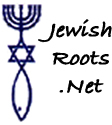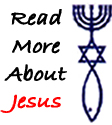






![]()
The name for this holiday probably comes from Psalm 118:25. Hoshana means to save. This is the seventh day of the Feast of Tabernacles. It comes one day before Shimini Atzeret. It is usually observed on the 21st day of the Hebrew month Tishri. It is also called "the great Hosanna."
Lord, do save, we beseech You; O Lord, we beseech You, do send prosperity! Psalm 118:25).
This is considered by most people to be the last
and greatest day of the Feast of Tabernacles. Hoshana Rabba can be  distinguished
from the rest of the days of the Feast of Tabernacles by at least three
features.
distinguished
from the rest of the days of the Feast of Tabernacles by at least three
features.
1) Hakafot. The congregation marches with Lulav and Etrog seven times around the bema (altar). This is an ancient ritual can can be found in Talmudic texts (Sukkah 45a). At one time, this may have been a privilege for Kohanim (priests) only. There may be a connection with Joshua marching around the walls of Jericho.(1)
2) A Day of Judgment. Hoshana Rabba is traditionally considered by some to be the concluding day of the judgment period which commemorates with Rosh HaShana. For those who don't believe this, they probably lean towards the view that the Day Of Atonement is the final day. The Zohar officially declares Hoshana Rabba a day of judgment (Tzav 31b).(1)
When viewed as a judgment day, its relationship to other judgment days may be as follows.
On Rosh HaShana, God's judgment is made concerning our fate.
On the Day of Atonement, the judgment is sealed.
On Hoshana Rabba, the judgment is delivered. This would make Hoshana Rabba the culminating day.
The Lulav is the symbol of victory and vindication on the judgment day. There is particular emphasis on the contest between the nations of the world and Israel. " Rabbi Ovin said: When two men appear before a judge, we know not who won. When one emerges with palm branches in his hand, we know that the verdict was in his favor.
Israel and the nations of the world come before the Almighty on Rosh HaShana to exchange mutual charges. We do not know who won. However when Israel comes out with Lulav in hand, we know that the verdict was in its favor" ( Vayikra Rabba 30).(1)
It may be this tradition, which apparently was alluded to, in the following Midrashic passage. The Messiah will teach six mitzvot to the nations of the world, among these the Sukkah and the Lulav (Shochar Tov, Ps.21).
3)Aravot. A bundle of willow branches is used in a special defoliation ritual at the morning service. According to the Talmud this custom was communicated orally to Moses at Mt. Sinai (Sukka 44a).(1)
The aravot symbolically represents the common people, who are devoid of scholarship and good deeds (Vayikra Rabba 30).
There is also a symbolic connection between the aravot and Joseph. The 21st day of Tishri is the traditional birthday of Joseph. This is also the calendar for Hoshana Rabba. There is a midrashic interpretation that connects the two. The willow branch symbolizes the life of Joseph. The willow withers sooner than the myrtle and lulav, like Joseph, who died in the lifetime of his brothers (Vayikra Rabba 30).(1)
Hoshana Rabbah became recognized as an official judgment day in modern Judaism when the Zohar declared it. During the worship service it is common to see congregations march around their worship room seven times (similar to Joshua marching around Jericho). Psalm 118 is chanted and when verse 25 is sung, and after the seventh cycle around the room the worshipers take the willow branches that they have been carrying and strike the ground with them until the leaves fall off. This is symbolic of the worshiper beating their sins away.
Sometimes these palm branches are saved and used to build a fire to burn bread just before Passover.
In some congregations, a white Torah cover is placed over the ark at the beginning of Rosh HaShana and remains up until after Hoshana Rabbah.
This is also a time when some things are removed from the Sukkah.
At one time there was a conflict when this holiday would land on the Sabbath. Some viewed it as superior to the Sabbath and therefore Hoshana Rabba customs overrode the Sabbath (Talmud;Mas. Sukkah 43b).
It is customary to dress up in good clothes for the service.
There is a customary greeting know as "Pikta Tava" which is Aramaic and literally means a good note. This greeting implies a good judgment from God.
The readings of scriptures are common. Some stay up all night doing this. Deuteronomy and Psalms are popular readings.
Sometimes the Torah is read. When this happens, Numbers 29:26-34 is often the verses recited.
There are a few who consider this day an extension of the Day of Atonement.
Some congregations have a custom where some of the people walk around the room that the Torah is being read from 7 times, while at the same time carrying the Lulav And Etrog. Then in an ancient rite of profound mystical significance, some beat five willow branches on the floor.(2)
Tradition has it that on this day God decides how much rain will fall for the coming year and where it will rain.(2)
 Messiah In The Hoshana Rabba Holiday:
Messiah In The Hoshana Rabba Holiday:It was on this day that the Gospel of John tells of Jesus speaking at the Water Libation Ceremony. At this time Jesus offers everyone the chance to have "living Water."
On the last and greatest day of the feast, Jesus stood up and exclaimed, Let anyone who thirsts come to me and drink. Whoever believes in me, as scripture says: Rivers of living water will flow from within him (John 7:37-38).
Jesus used the Water Libation Ceremony as an object lesson and opportunity to make a very public invitation on the last day of the feast for His people to accept Him as the living water. His words here recall Isaiah 55:1. thirsty ...come...drink. These 3 words summarize a gospel invitation. A recognition of need leads to an approach to the source of provision, followed by receiving what is needed. The thirsty, needy soul feels the craving to come to the Savior and drink, i.e. receive the Salvation that He offers.(3)
By Accepting Jesus as the living water you would receive the gift of the indwelling of the Holy Spirit. It is this Holy Spirit gift that is often referred to as "living water."
For a list of future holidays dates, check the Master Calendar Table.
Have you drank from the living water God has offered?
1). Some of the information from this page came from The Biblical And Historical Background Of The Jewish Holy Days, by Abraham P. Bloch. It is copyrighted material and was used with permission of the publisher, KTAV Publishing, 900 Jefferson Street. Box 6249, Hoboken, NJ 07030-0102
2). Your Tishrei Guide 5766 (2005) Outreach Publishing Corp. and Chabad of Peoria.
3). The MacArthur Study Bible (NASB) p.1563.
Greg Killian